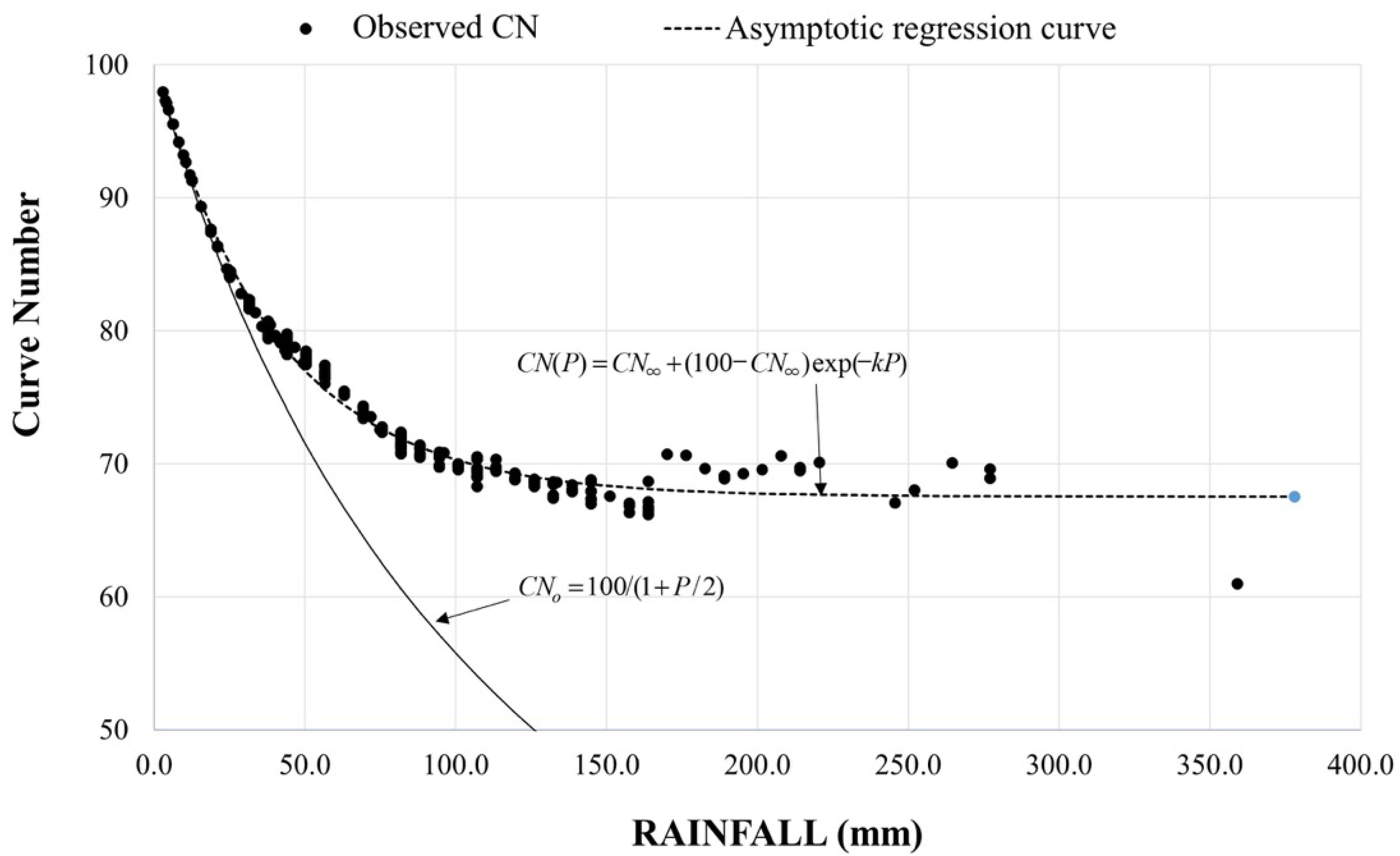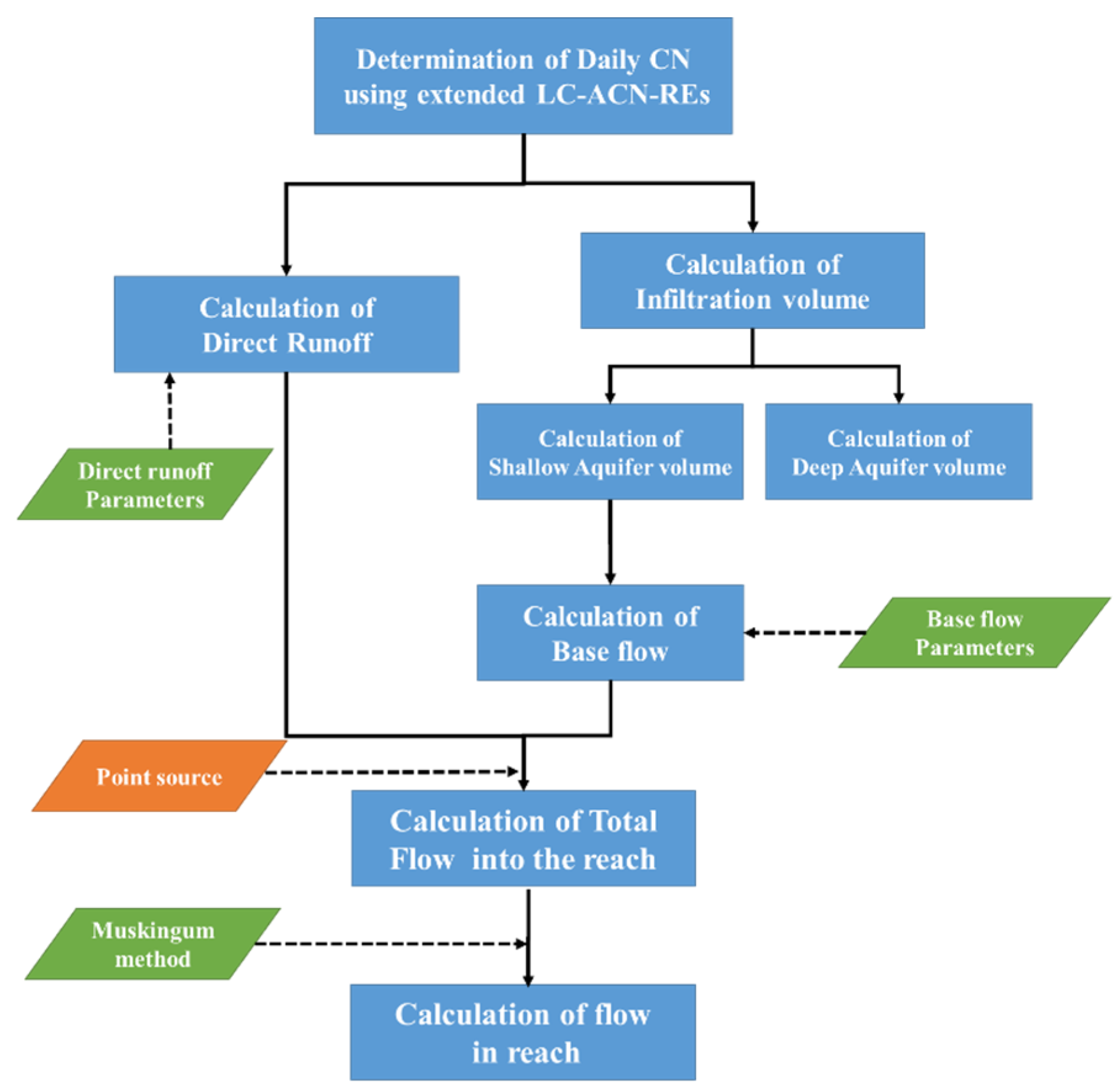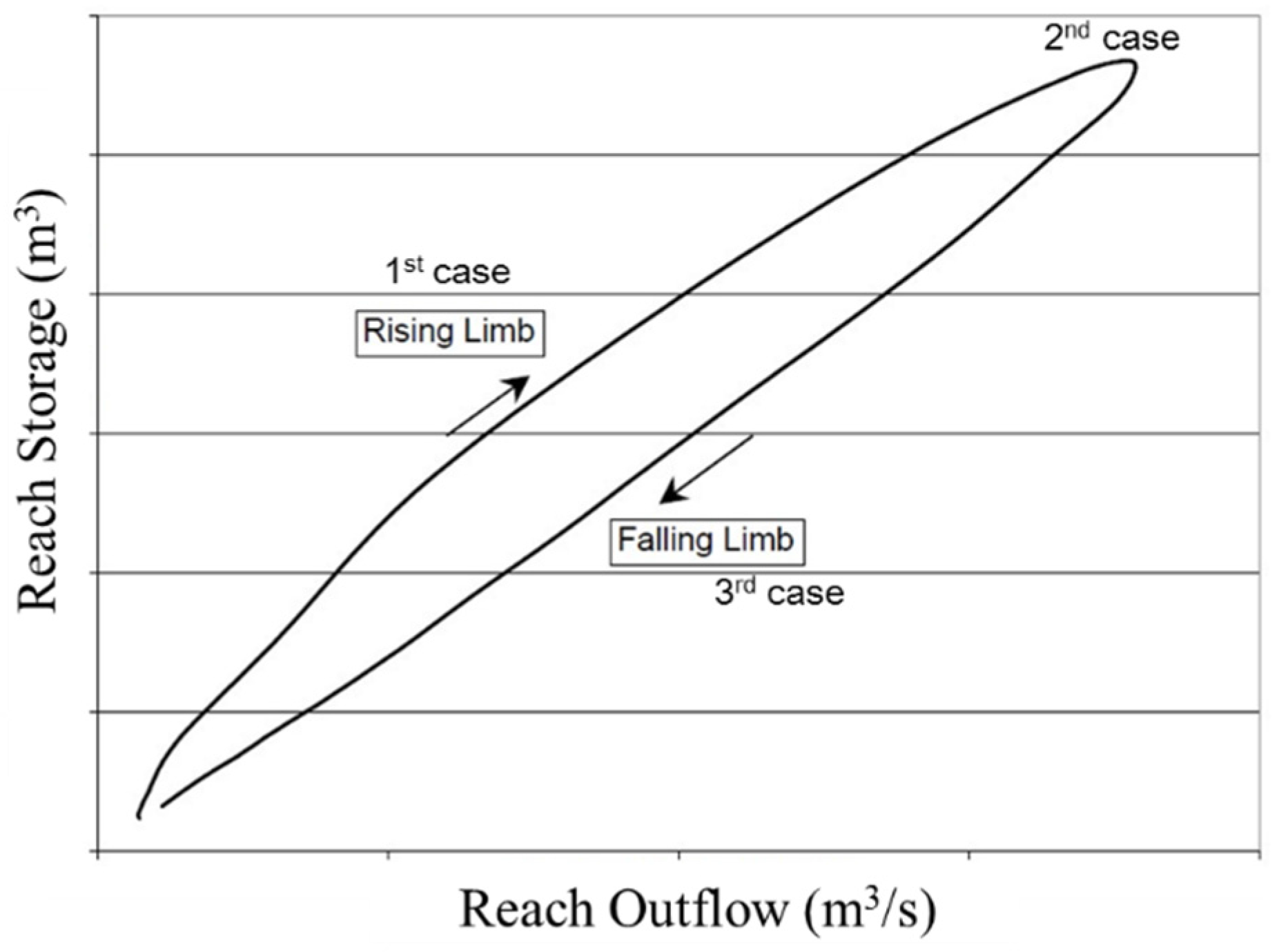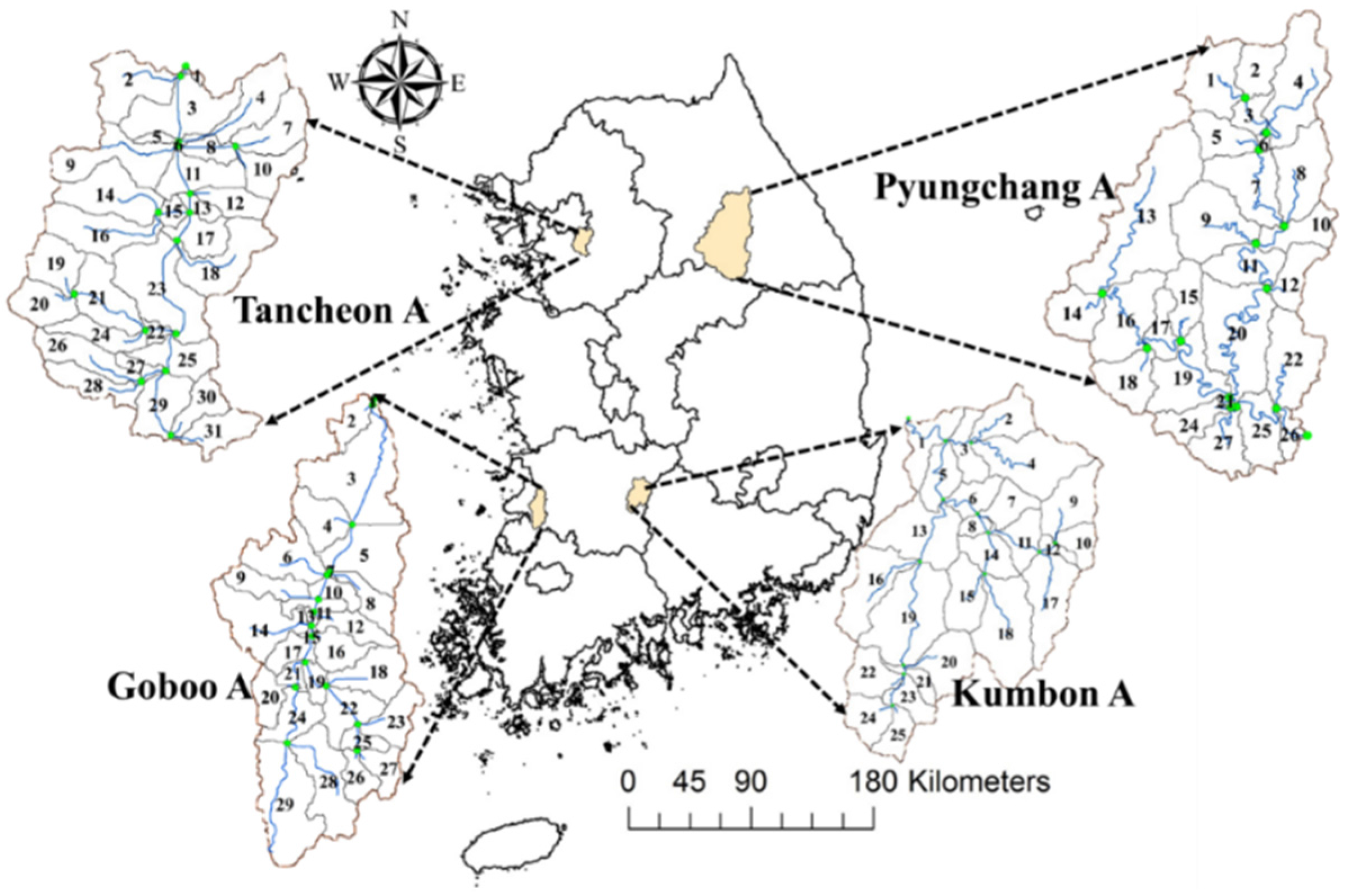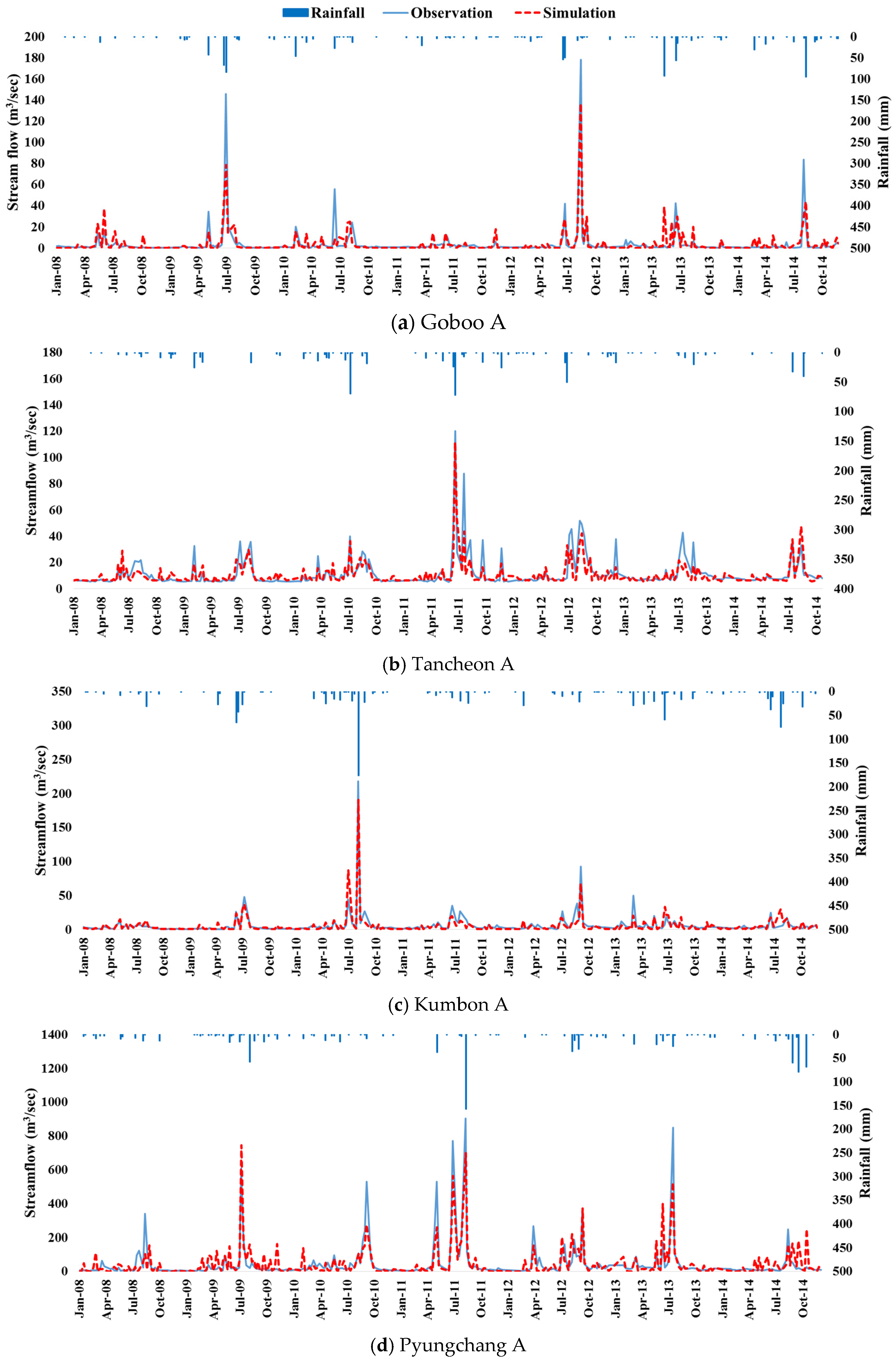2.2.1. Development of the Direct Runoff Estimation Module
As explained above, the 52 asymptotic regression equations (Equation (2)) were obtained for 13 land cover types and four HSGs. Using these equations, the CN values for a given set of daily rainfall data were computed for all land cover and HSG combinations for each watershed studied.
According to various studies on the NRCS-CN method, CN values can be adjusted based on the slope in a watershed [
39], as well as for various local conditions that affect rainfall–runoff. Thus, an adjustment coefficient was added to explain the effect of the slope on the CN values (Equation (3)). In this study, the limits of the range for the adjustment coefficient for CN were set to −0.1 and +0.1 (−10% and +10%).
where
CNHRU is the adjusted CN value for HRU,
Adj_CNHRU, ACN is the CN value determined from the extended LC-ACN-REs and
Adj_CN is the adjusted coefficient for CN.
After adjustment of the CN values, the direct runoff of each HRU was estimated (Equation (4)).
where
Q1DR,HRU is the amount of direct runoff generated by an HRU for each day (mm),
P is the rainfall (mm),
S is the potential maximum retention (mm) and
Adj_CNHRU,ACN is the adjusted coefficient for CN.
In a large-scale watershed, the amount of direct runoff that occurs on a day can be lagged, and only a portion of the direct runoff will flow into a stream on a day. Thus, in this study, the direct runoff delay process was addressed in the module in the form of an exponential function of the time of concentration (TC) and the lag coefficient (
DRlag), as proposed in the SWAT model (Equation (5)) [
38].
Once the direct runoff of each HRU is calculated using Equation (4), the amount of direct runoff flowing into the stream can be calculated using Equation (5).
where
QDR,HRU is the amount of direct runoff discharged to the main channel on a given day (mm),
Q1DR,HRU is amount of direct runoff generated by the HRU on a given day (mm),
Qstor is the direct runoff lagged from the previous day,
DRlag is the direct runoff lag coefficient and
TC is the time of concentration (h).
The value of the lag coefficient (
DRlag) ranges from 1 to 12 and should be provided by the user after investigating watershed characteristics or related documents. The time of concentration is defined as the time required for water to flow from a remote point in a watershed to a watershed outlet. The time of concentration is important in the rainfall runoff model and can be estimated from various formulas, although the variability of the estimates of the time of concentration given by various formulas can be high [
40]. There are two types of time of concentration: the time required for overland flow and the time required for channel flow. These are calculated from watershed-specific information, such as the average slope (
m/
m), the slope length (m), the channel length from the most distant point to the subbasin outlet (km) and Manning′s coefficient,
n, as shown in Equations (6) and (7) [
38,
41]. Equations (4) and (5) were added to the direct runoff module of the watershed-scale L-THIA ACN model.
In these equations, TCO is the time of concentration for overland flow (h); TCC is the time of concentration for channel flow (h); LSlope is the HRU slope length (m); n is Manning′s coefficient for overland flow; nC is Manning’s coefficient for channel flow; Slope is the average slope of the HRU (m/m); SlopeC is the channel slope (m/m); L is the channel length from the most distant point to the subbasin outlet (km); and Area is the area of the HRU (km2).
In this study, the values of Manning’s coefficient from
Table 2 were used for the calculation of
TCO, and the values of Manning’s coefficient for
TCC were calibrated based on the land cover and the parameter range, based on
Table 2. The
Slope, the
Area of the HRU and the channel length
L from the most distant point to the subbasin outlet (km) were calculated using a GIS tool for the purpose of computing the time of concentration for overland flow and the time of concentration for channel flow.
However, because the calculation of the slope length is strongly affected by the digital elevation model (DEM) cell size, the field slope length can be overestimated when it is calculated using a GIS tool [
43]. Furthermore, the DEM resolution, slope length, river networks and flow length estimation are among the major source of uncertainties in rainfall–runoff modeling [
44]. Thus, in this study, the slope length of each HRU was calculated from the relationship between the field slope length and the average field slope, as proposed in [
45]. This relationship between the field slope length and the average field slope (
Table 3) was added to the direct runoff module in the watershed-scale L-THA ACN model. However, this relationship, described in
Table 3, was obtained from measurements made in the USA. Thus, to reflect local field slope length properties, an additional parameter (
SLSUB) was added to adjust the slope length.
After calculation of the direct runoff for each HRU released to the stream, the direct runoff of each subbasin was calculated by summing the direct runoff from all HRUs within each subbasin (Equation (8)):
where
QDR,sub is the amount of direct runoff generated in the subbasin on a given day (mm).
2.2.2. Development of Baseflow Module
The NRCS-CN method and LC-ACN-REs are both used for direct runoff estimation, but not for baseflow computation for a watershed. The baseflow component was developed and linked to the watershed-scale L-THIA ACN model for use in watershed hydrology studies, as well as evaluation of the water quality of a watershed.
According to Dingman [
46], the aquifer in a watershed is composed of two aquifers, an unconfined aquifer and a confined aquifer. Water recharged into an unconfined aquifer contributes to flow in the main channel and influences the amount of streamflow, while water recharge into a confined aquifer is assumed to flow somewhere outside of the watershed [
47].
Based on the user-defined fraction of infiltrated water flowing into the confined aquifer from each HRU, the amount of infiltrated water flowing into the unconfined aquifer can be estimated. The baseflow module, which was developed and integrated into the watershed-scale L-THIA ACN model, simulates these processes to account for the baseflow contribution to streamflow in a watershed. The water balance in an unconfined aquifer is calculated according to Equation (9):
where
aqfHRU,i is the amount of water stored in an unconfined aquifer on a given day (mm),
aqfHRU,i-1 is the amount of water stored in the unconfined aquifer on the previous day (mm),
ωunconf,HRU is the amount of recharge entering the unconfined aquifer on that day (mm) and
QBF,HRU is the amount of baseflow into the main channel (mm).
The amount of water recharged into both aquifers (confined and unconfined) is estimated using the exponential decay weighting function (Equation (10)) proposed by Venetis [
48] and used by Sangrey
et al. [
49] in their precipitation–groundwater response model and by Neitsch
et al. [
38] in the SWAT model:
where
ωrcharg,HRU,i is the amount of recharge entering both aquifers on a given day (mm),
BFdelay is the delay time in aquifer recharge once the water infiltrates from the surface (days),
FHRU,i is the amount of infiltration on the given day (mm) and
ωrcharg,,HRU,i-1 is the amount of recharge that enters the aquifers on the previous day (mm).
The amount of infiltration on a given day is calculated using Equation (11), which is modified from that used in the NRCS-CN method [
22] and was used by Kim
et al. [
50] to estimate the CN-based infiltration and baseflow:
where
FHRU,i is the amount of infiltration on a given day (mm),
S is the is the potential maximum retention (mm),
P is the rainfall (mm),
Adj_CNHRU, ACN is the CN value determined from the extended LC-ACN-REs and
Ia is the initial abstraction (mm).
In the baseflow module, only a fraction of the infiltrated water is assumed to flow into the unconfined aquifer, based on the user-defined fraction of infiltrated water flowing into the confined aquifer (Equations (12) and (13)):
where
ωconf,HRU is the amount of infiltrated water flowing into a confined aquifer on a given day (mm),
Frconf is the fraction of water flowing into the confined aquifer and
ωunconf,HRU is the amount of recharge entering the unconfined aquifer on that day (mm).
The amount of water flowing into an unconfined aquifer contributes to baseflow only if the amount of water in the unconfined aquifer exceeds a threshold value specified by the user that depends on the aquifer′s characteristics. The steady-state response of the baseflow is expressed by Equation (14) [
51]:
where
QBF,HRU is the amount of baseflow into the main channel (mm),
ksat is the hydraulic conductivity of the aquifer (mm/day),
LBF is the distance from the ridge or subbasin divide for the baseflow to the main channel (m) and
hwtbl is the water table height (m).
The water table height (
hwtbl) depends on the baseflow response in the non-steady state and is calculated using Equation (15) [
52]:
where
is the change in the elevation of the water table (mm/day),
is the amount of recharge entering the unconfined aquifer on a given day (mm),
QBF,HRU is the baseflow into the main channel on that day (mm) and
μ is the specific yield of the unconfined aquifer (
m/m).
Combining Equations (14) and (15) yield Equation (16) [
38]:
where
QBF,HRU is the baseflow into the main channel on a given day (mm),
ksat is the hydraulic conductivity of the aquifer (mm/day),
LBF is the distance from the ridge or subbasin divide for the baseflow to the main channel (m),
μ is the specific yield of the unconfined aquifer (
m/m),
ωunconf,HRU is the amount of recharge entering the unconfined aquifer on that day (mm) and
αBF is the baseflow recession constant.
After integrating and rearranging Equation (14),
QBF,
HRU can be expressed by Equation (17) [
38]:
where
QBF,HRU,i is the baseflow into the main channel on a given day (mm),
QBF,HRU,i-1 is the baseflow into the main channel on the previous day,
αBF is the baseflow recession constant,
ωunconf,HRU is the amount of recharge entering the unconfined aquifer on the given day (mm),
∆t is the time step (one day),
aqf is the amount of water stored in the unconfined aquifer on the given day (mm) and
aqfthr is the threshold water level in the unconfined aquifer for baseflow contribution to the main channel to occur (mm).
The baseflow recession constant (
αBF) in Equation (17) reflects the baseflow response to the amount of recharge [
52]. Values between 0.1 and 0.3 represent slow response conditions in a watershed, and values between 0.9 and 1.0 represent rapid response conditions [
38,
52]. Two options (simple long-term daily average and daily time series point source capabilities) were enabled in the direct runoff module to simulate the effects of discharge from Waste Water Plants (WWP) or other point sources on watershed hydrology and water quality.
2.2.3. Development of Channel Routing Module
Streamflow flows downward and meets flow from other upper streams in channel networks. The amount of streamflow in a watershed is affected by various mechanisms. In this study, a channel routing module was integrated into the watershed-scale L-THIA ACN model for simulation of flow routing using the Muskingum routing method [
53]. The Muskingum routing method estimates the storage volume in a channel length as a combination of wedge and prism storage [
53]. The concept of the Muskingum routing method is illustrated in
Figure 3. The first case represents the storage in the river during the rising limb of a hydrograph; the second case represents uniform flow; and the third case represents the storage during the falling limb of the hydrograph. This hysteresis might cause different flood wave speeds during the rising and falling limbs of the hydrograph [
54].
The effects of these variables and the reach storage–discharge relationship are expressed by the equation used in the Muskingum routing method to estimate the reach storage volume,
Vstor:
where
Vstor is the reach storage volume (m
3/s),
K is the storage time constant for the reach (s),
X is the weighting factor,
qin is the inflow rate (m
3/s) and
qout is the outflow rate (m
3/s).
Equations (18) and (19), proposed by Williams [
55], can be combined and simplified as Equation (20):
where
qin is the inflow rate at the beginning of the time step (m
3/s),
qin,∆t is the inflow rate at the end of the time step (m
3/s),
qout is the outflow rate at the beginning of the time step (m
3/s),
qout,∆t is the outflow rate at the end of the time step (m
3/s) and
C1,
C2 and
C3 are expressed by Equations (21)–(23), respectively.
The value for the weighting factor,
X, is a user input. The value of the storage time constant,
K, is calculated using Equation (24):
where
K is the storage time constant for a reach segment (s),
Mk1 and
Mk2 are weighting factors input by the user,
bankfull is the storage time constant estimated for the reach segment with bankfull flows (s) and
bankfull0.1 is the storage time constant estimated for the reach segment with one tenth of the bankfull depth (s).
The value of
bankfull can be calculated using Equation (25) [
38,
53]:
where
bankfull is the storage time constant estimated for the reach segment with bankfull flows (s),
Lreach is the stream length (m) and
c is the celerity corresponding to the flow for the specified depth (m/s).
The value of
c can be determined from Equation (26), using the cross-sectional area of the stream and Manning’s equation [
38]:
where
A is the cross-sectional area of flow in the stream (m
2),
qch is the flow rate in the stream (m
3/s),
R is the hydraulic radius for a given depth of flow (m),
I is the slope (
m/m) and
n is Manning’s coefficient for the channel.
To calculate
Vc in Equation (26), the metacenter of the streams should be evaluated, and the actual shapes of all of the streams in each subbasin should be measured. However, it would be difficult to measure the cross-sections of all of the streams. In this study, all streams in subbasins were assumed to be trapezoidal channels with side slopes of 0.5, and the slope of the flood plain was assumed to be 0.25. These assumptions are similar to those made in the SWAT model [
38].
